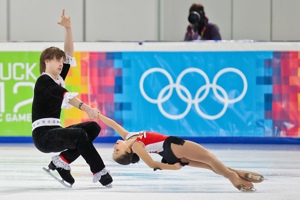Figure Skating Rules

Figure Skating is a sport in which single athletes or teams of athletes conduct artistic performances on ice. Both men and women participate in their own singles events with pair skating events and ice dancing events open to both genders (usually one male and one female).
Athletes produce a wide variety of moves in order to impress a panel of judges, who score the athletes based on their grace, flair and control. Moves include jumps and spirals in the air, spins on the ice and a number of different step sequences.
Figure Skating has been a part of the Winter Olympics since the games first began in 1924, and also made appearances at 1908 and 1920 Summer Olympics before that.
The United States are the current world leaders in Olympic Figure Skating, holding a total of 49 medals overall. Russia and Austria are the closest rivals with 26 and 20 medals, respectively. The Soviet Union also picked up 24 medals during their time in the competition.
Object of the Game
The overall objective in Figure Skating is to score the highest marks possible from the judges, although there are different ways to score points depending on the nature of the event.
For all Figure Skating competitions, athletes are required to perform a number of different moves in order to obtain the highest possible score from the judges. During a typical performance, athletes will execute a selection of spins, jumps and steps.
In pair skating competitions, athletes perform actions with one another in order to score high points, such as throwing a partner in the air and spinning the partner around in various directions.
Ice dancing is somewhat similar to pair skating, although the focus here on is on footwork and coordination as partners dance together in time with music being played overhead.
Players & Equipment
Both men and women participate in Figure Skating, and there is little equipment involved other than specially made pairs of skates called “Figure Skates”.
Figure Skates
Figure Skates are specially designed skating shoes with thick steel blades at the base and jagged grooves at the front known as “toe picks” – which assist athletes with their footwork on the ice, as well as landing and spinning. The specific style of toe picks can vary.
The main blades are ordinarily around 4 millimetres thick, although they can vary depending on the shoe size of the athlete. They also curve round to one side in order to assist with turns on the ice.
Athletes will always attempt to skate on the very edges of the figure skate blades.
For ice dancing, athletes usually have slightly shorter blades on the base of their shoes, with slightly different design to accommodate step-work rather than jumping.
Costumes
Men and women are required to wear specific costumes in order to perform on the professional stage. Men are asked to wear trousers, whilst women are required to wear tights, trousers, or unitards, as well as skirts.
Scoring
Athletes in Figure Skating are scored according to the ISU Judging System by a panel of judges (usually nine judges including a technical inspector, and also a referee). This system functions by awarding athletes different amounts of points for different types of moves, as well as how efficiently and effectively these moves are executed. A Grade of Execution (GoE) is calculated, and then a Scale of Value Table is used to turn this grade into an overall mark.
The main aspects scored during a typical Figure Skating performance include skill, footwork, performance, interpretation, overall execution, choreography and timing. Often, the more complex manoeuvres will be scored highest provided they are executed correctly. For example, the more rotations in a jump will lead to a higher mark.
Winning
The winner of a Figure Skating event is the individual/team who achieves the highest overall score.
Rules of Figure Skating
- Athletes in Figure Skating must keep their performances varied. The Zayak Rule states that no participant can attempt triple or quadruple jumps on more than two occasions.
- Judges may also mark down participants or disqualify them completely if they fail to adhere to rules and regulations for music and costumes. Certain types of music are not permitted, and costumes cannot contain “excessive decoration” or be considered as too revealing.
- Athletes can also be disqualified for time violations.